Upimaji wa Uwezo kusikia hupima sikio la kulia na la kushoto la mhusika ili kuangalia kama mhusika amepoteza usikivu. Matokeo husaidia ninyi wawili kuamua kama utumiaji wa vifaa saidizi vya kusikia utaweza kusaidia.
Maelekezo
Tumia sehemu ya kipimo cha kusikia katika fomu ya tathmini na uangalie jedwali la upotevu wa kiwango cha uwezo wa kusikia ili kujua kama mtu huyo amepoteza usikivu.
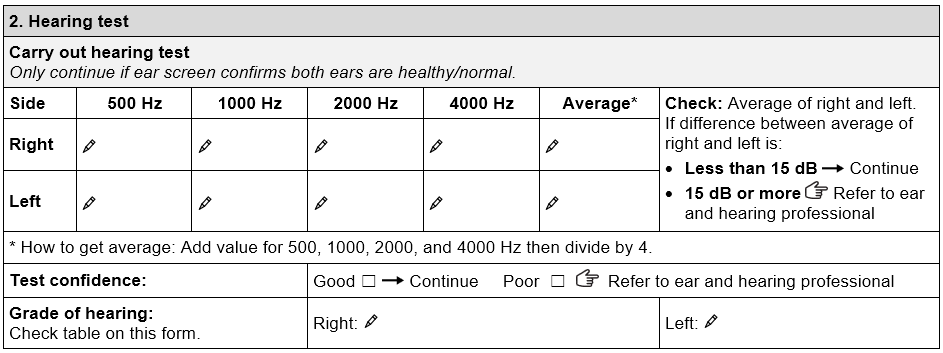
Dokezo
Vidokezo vifuatavyo vitarahisisha kuzungumza na mtu ambaye anapata shida kusikia:
- Ongea vizuri na taratibu. Usipige kelele.
- Simama/keti eneo lenye mwanga mzuri na mtazame mtu huyo ili aweze kuona uso wako unapozungumza.
- Usizidishe namna unavyozungusha midomo yako. Hii inaweza kufanya iwe vigumu kwa mtu kupata kile unachosema.
- Jaribu kupunguza zinazotoka nje ya eneo kwani hii inafanya iwe kufanya iwe vigumu kwa mtu kusikia, hata pale anapotumia vifaa saidizi vya kusikia.
- Ikiwa kuna watu zaidi ya mtu chumbani, basi mtu mmoja azungumze baada ya mwingine, sio wote kwa wakati mmoja. Hii hurahisisha mtu mwenye changamoto ya kusikia kuweza kushiriki katika mazungumzo.
Swali
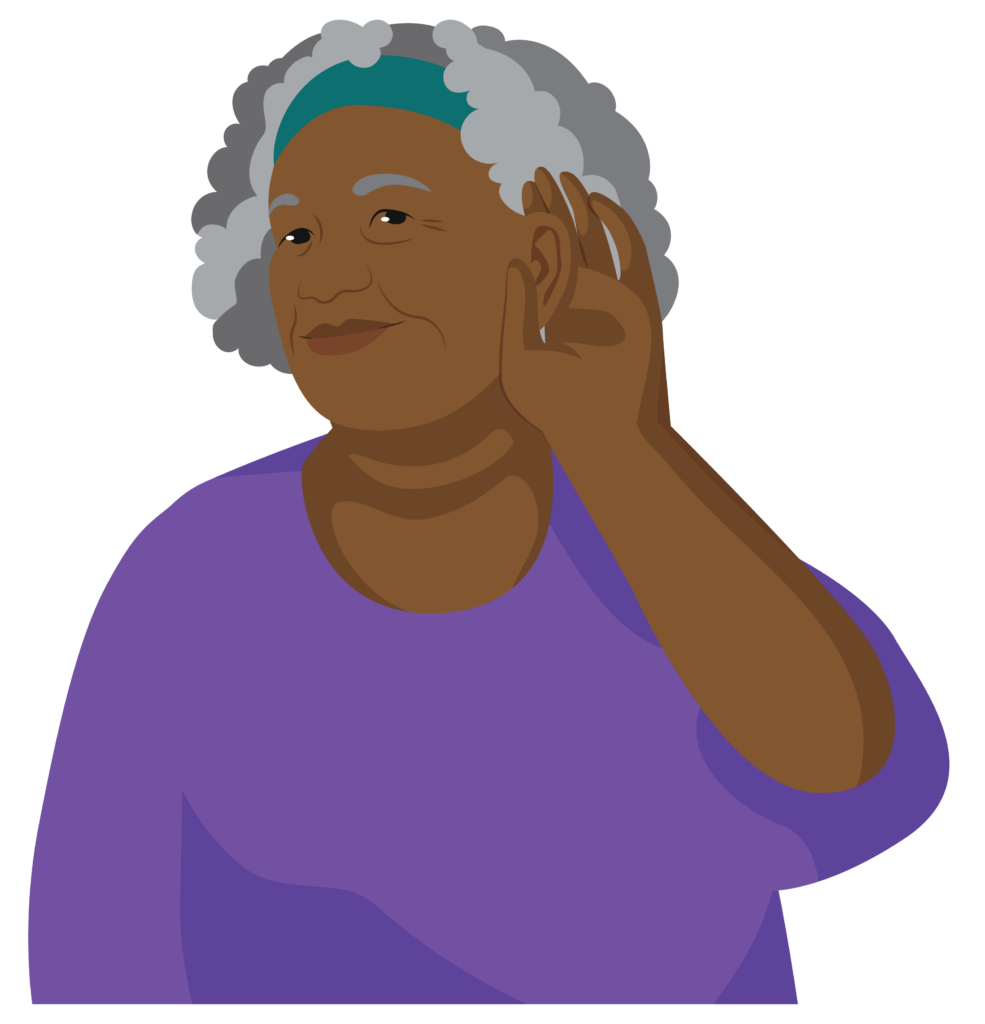
UnamKumbuka Malicka?
Malicka ana umri wa miaka 70 na hasikii vizuri.
Wakati wa kipimo cha usikivu. Malicka anamwomba Mhudumu wa afya kurudia kile anachosema.
Je, Mhudumu wa afya angeweza kufanya nini ili kurahisisha kwa Malicka?
Chagua majibu mawili.
Uko sahihi Ikiwa umechagua c na d kama majibu sahihi !
Kumtazama Malicka ukiwa eneo lenye mwanga mzuri huku ukizungumza vizuri na taratibu kutamrahisishia kuelewa unachosema.
Kila mara fanya upimaji wa afya ya masikio ili kuangalia masikio ya mgonjwa kabla ya kumpima Uwezo wa masikia.
Ikiwa mtu ana shida ya afya ya masikio; shida hii inaweza kufanya matokeo ya kipimo cha kusikia kuwa mabaya zaidi.
Kutibu tatizo la afya ya masikio kwanza kutatoa matokeo sahihi zaidi ya kipimo cha kusikia.
Ufanyaji wa kipimo cha usikivu
Wakati wa kufanya kipimo cha kusikia:
- Eleza kuhusu kipimo cha uwezo kusikia
- Fanya mazoezi ya majibu ya kipimo
- Fanya kipimo cha usikivu
- Kukotoa wastani wa kiwango cha usikivu
- Rekodi matokeo kwa kila sikio.
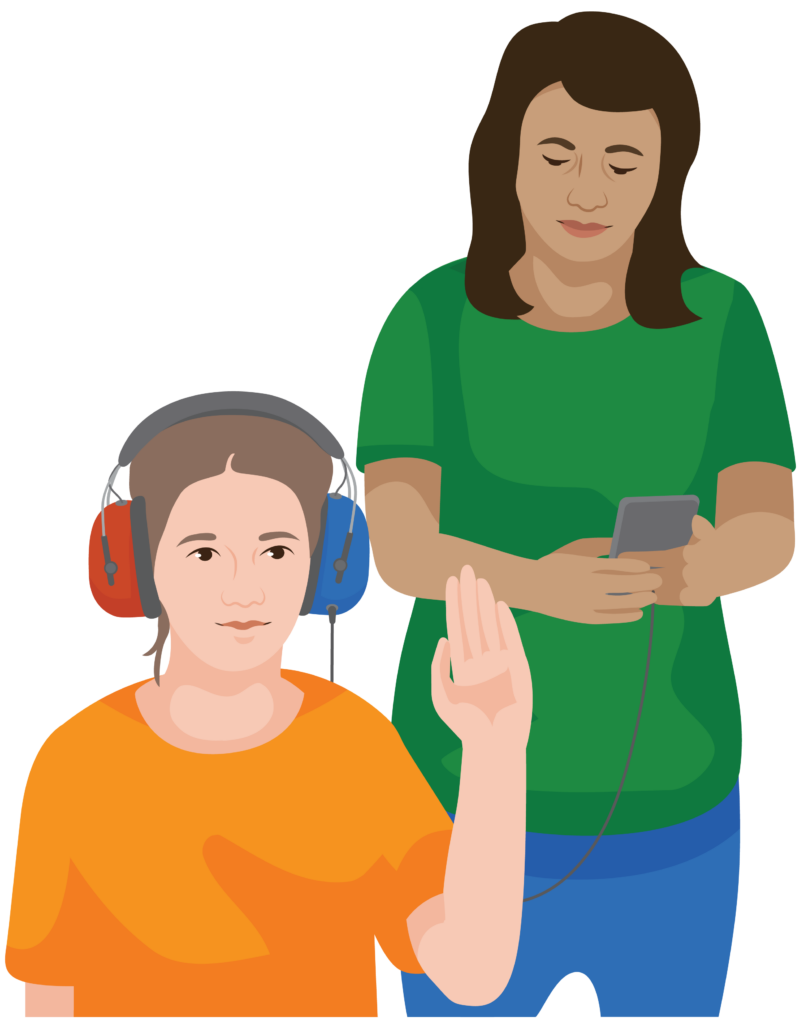
1. Eleza kuhusu kipimo cha uwezo kusikia
Eleza kwamba uTAPima usikivu kwa kupima sauti chini zaidi ambayo mgonjwa huyo anaweza anaweza kusikia (kiwango cha chini zaidi).
2. Fanya mazoezi ya majibu ya kipimo
Elezea:
- Mara tu unaposikia sauti, bonyeza kitufe cha kujibu au inua mkono wako
- Achia kitufe au upunguze mkono wako mara tu usiposikia sauti tena.
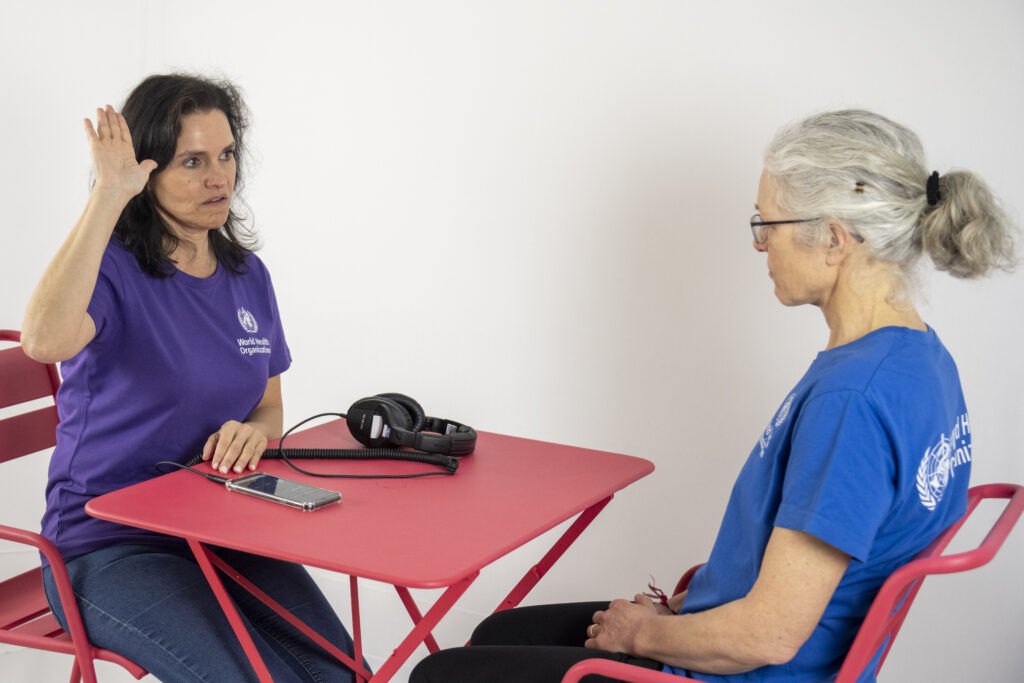
Fanya mazoezi na mgonjwa kwanza kwa masafa ya 1000 Hz na 40 dB:
- Muombe mhusika kuinua mkono wake pale atakaposikia sauti na ashushe mkono wake sauti inapokoma
- Rudia mara mbili kwa kila sikio
- Kama mtu anayepimwa hawezi kusikia sauti inayotolewa wakati wa mazoezi, ongeza sauti kwa 10 dB na kurudia.
Maelekezo
Ikiwa mtu huyo hatafaulu mazoezi, usiendelee na kipimo cha kusikia. Toa rufaa mtaalamu wa masikio na kusikia.
Kabla ya kuanza kipimo, muulize mtu huyo anayeopimwa kama anasikia vizuri kwa sikio mojawapo.
- Anza na sikio linalosikia vizuri
- Kama hawasikii vizuri kwa sikio mojawapo, anza kupima sikio la kulia.
Swali

UnamKumbuka John?
John anapata shida katika kusikia. Ametembelea kituo cha kutolea huduma ya afya ya eneo analoishi ili kufanyiwa upimaji wa Afya ya masikio na Uwezo kusikia.
Mhudumu wa afya anamuuliza John kuhusu sikio lake ambalo linasikia vizuri zaidi? John hana uhakika.
Je, Mhudumu wa afya anapaswa kuanza kukagua sikio la upande upi?
Chagua jibu moja.
Uko sahihi kama umechagua " b" kama Jibu sahihi
John hana uhakika kama ana sikio linalosikia vizuri zaidi. Anza na sikio lake la upande wa kulia.
majibu a, c na d sio sahihi.
Kuanza na sikio linalosikia vizuri zaidi (Ikiwa linajulikana) kUnaweza kumsaidia mtu kujiamini zaidi kuhusu mchakato wa kipimo kwani itakuwa rahisi kwake kusikia sauti ya kipimo.
3. Fanya kipimo cha kusikia
- Muombe mhusika avae vipokea sauti vinavyochuja kelele. Kagua kama vipokea hivi viko katika nafasi sahihi.
- Anza kipimo kwenye sikio linalosikia vizuri zaidi. Kama sikio linalosikia vizuri halijulikani, anza na sikio la upande wa kulia.
- Weka masafa kwenye kiwango cha 1000 Hz na 40 dB.
Dokezo
Ili kufanya kipimo kwa usahihi zaidi:
- Kaa mahali ambapo mhusika hataweza kukuona ukiWasilisha sauti
- Badilisha mdundo wa namna unavyoWasilisha sauti. Hii ni kuzuia mtu kubahatisha ni lini utaWasilisha sauti inayofuata.
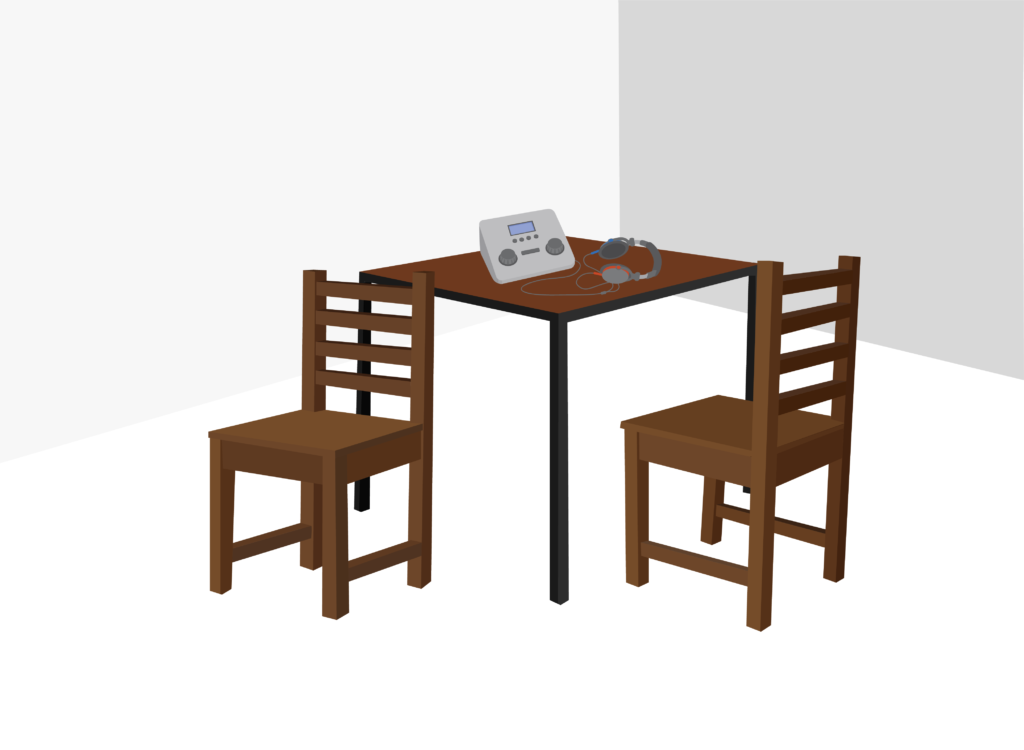
sauti za masafa ya juu zaidi ya 1000 Hz kwa kawaida ni rahisi kusikika na humpa mtu kujiamini mwanzoni mwa kipimo cha usikivu.
- Bonyeza kitufe kwa sekunde 2 hadi 3 na uone Ikiwa mtu huyo atainua mkono wake:
- Ikiwa mtu atainua mkono wake, punguza kiwango cha mshindo kwa 10 dB
- Ikiwa mtu hajibu, ongeza kiwango cha sauti kwa 5 dB
- Endelea hadi upate sauti ya chini kabisa ambayo mtu anaweza kusikia:
- Rudia sauti mara tatu ili kuthibitisha kiwango cha chini kabisa ambacho mtu anaweza kusikia
- Kama mtu anajibu kwa usahihi angalau mara mbili kati ya tatu katika masafa aliojaribiwa, rekodi kiwango hiki kwenye fomu
- Rudia upimaji katika masafa 2000 Hz, 4000 Hz na 500 Hz
- Rudia kupima sikio la upande wa kushoto la mhusika.
Maelekezo
Tazama Video hii ya kipimo cha usikivu linalofanywa kwa kutumia programu ya kipima sauti kwenye simu janja.
Swali
1. Ni kiwango gani cha kelele cha chinichini kinachofaa kwa kipimo cha kusikia?
Chagua jibu moja.
Chini ya 40 dB ndio Jibu sahihi!
Kiwango cha sauti kinapaswa kuwa chini ya 40 dB. Badilisha mazingira au eneo la kipimo cha usikivu Ikiwa kiwango cha sauti kiko juu ya 40 dB.
2. Ikiwa mtu hajibu sauti wakati wa kipimo cha kusikia. Unapaswa kufanya nini baadaye?
Chagua na ubofye ili kuangalia majibu.
Sio sahihi.
Haupaswi kupunguza kiwango cha sauti kwani mtu huyo bado hataweza kusikia sauti.
Sahihi!
Ongeza kiwango cha sauti kwa 5 dB na uone kama mtu anayepimwa anaitika. Ikiwa mtu anajibu rudia sauti mara tatu ili kuthibitisha kuwa umepata kiwango kidogo cha sauti kinachosikika.
Sio sahihi.
Usisitishe kipimo cha usikivu hadi upate sauti ya chini kabisa ambayo mtu anapimwa naweza kusikia.
Dokezo
Usiache kubofya kitufe haraka sana unapoWasilisha sauti ya kipimo. Ni muhimu kuruhusu walau sekunde 2 hadi 3 kwa mtu anayepimwa ili kuweza kusikia sauti.
Kazi
Katika vikundi, badilishaneni nfasi mmoja awe mpimaji mwingine anayepimwa.
Andaa:
- Ainisha nafasi na uangalie kiwango cha sauti kinachofaa kwa kutumia mita ya kupima kiwango cha sauti au kupakuliwa Programu ya kusikia ya WHO:
- Bofya kwenye 'angalia Uwezo wako wa kusikia' ili kufikia mita inayopima kiwango cha sauti
- Ruhusu upimaji wa kelele
- Andaa kipimo kwa njia ambayo mtu anayepimwa hawezi kukuona.
Kipimo:
- Elezea kipimo
- Fanya kipimo kwa 1000, 2000, 4000 na 500 Hz kwenye sikio lenye Uwezo mzuri zaidi wa kusikia la au sikio la upande wa kulia.
- Unapofikia kiwango kidogo cha sauti ambacho mtu anaweza kusikia, rudia mara tatu
- Thibitisha kuwa mtu anayepimwa ameweza kujibu kwa usahihi mara mbili kati ya tatu
- Rekodi sauti ya chini kabisa ambayo mtu anaweza kusikia
- Rudia kipimo kwenye sikio lingine.
Pima kujiamini
Fikiria jinsi unavyojiamini kuhusu matokeo ya kipimo cha kusikia.
Unawezakujiamini Ikiwa mtu huyo:
- Anajibu kila wakati sauti zinapowasilishwa
- Kiwango chake cha chini cha kusikia sauti kwa kila masafa kinatambuliwa.
Unaweza kujiamini kwa kiwango kidogo au kutokuwa na imani Ikiwa mtu huyo:
- Anajibu kiholela kuhusu sauti zinazowasilishwa
- Anajibu bila hata kama hakuna sauti inayowasilishwa
- Anajibu tu pale anapoona mpimaji anasogea.
Kama una:
- Unajiamini kwa kipimo kizuri. Endelea
- Kuamini kipimo kwa kiwango duni Jadili na mshauri wako. Mpeleke mhusika kwa mtaalamu wa masikio na kusikia kama itafaa.
Onyo
Matokeo sahihi ya mtihani ni muhimu kwa upangaji sahihi wa vifaa saidizi vya kusikia.
4. Kokotoa kiwango cha wastani cha kusikia
- Pata Wastani wa dB kwa kuongeza kiwango kwa 500 Hz, 1000 Hz, 2000 Hz na 4000 Hz kisha gawanya kwa nne.
- Linganisha Wastani wa kiwango cha chini kabisa ambacho sikio la kulia na kushoto yanaweza kusikia:
- Pungufu ya dB 15 Endelea
- Tofauti ya dB 15 Toa rufaa kwenda kuonana na mtaalamu wa masikio na usikivu.
Tofauti ya dB 15 dB au zaidi
Watu waliopoteza usikivu kwenye sikio la upande mmoja (upande mmoja) na wale waliopoteza usikivu usio na usawa ni mifano ya watu ambao wana tofauti ya 15 dB au zaidi au Wastani wa kiwango cha chini ambacho sikio la kulia na la kushoto yanaweza kusikia. Mahitaji yao ni makubwa zaidi. Wape rufaa kwenda kwa mtaalamu wa masikio na kusikia.
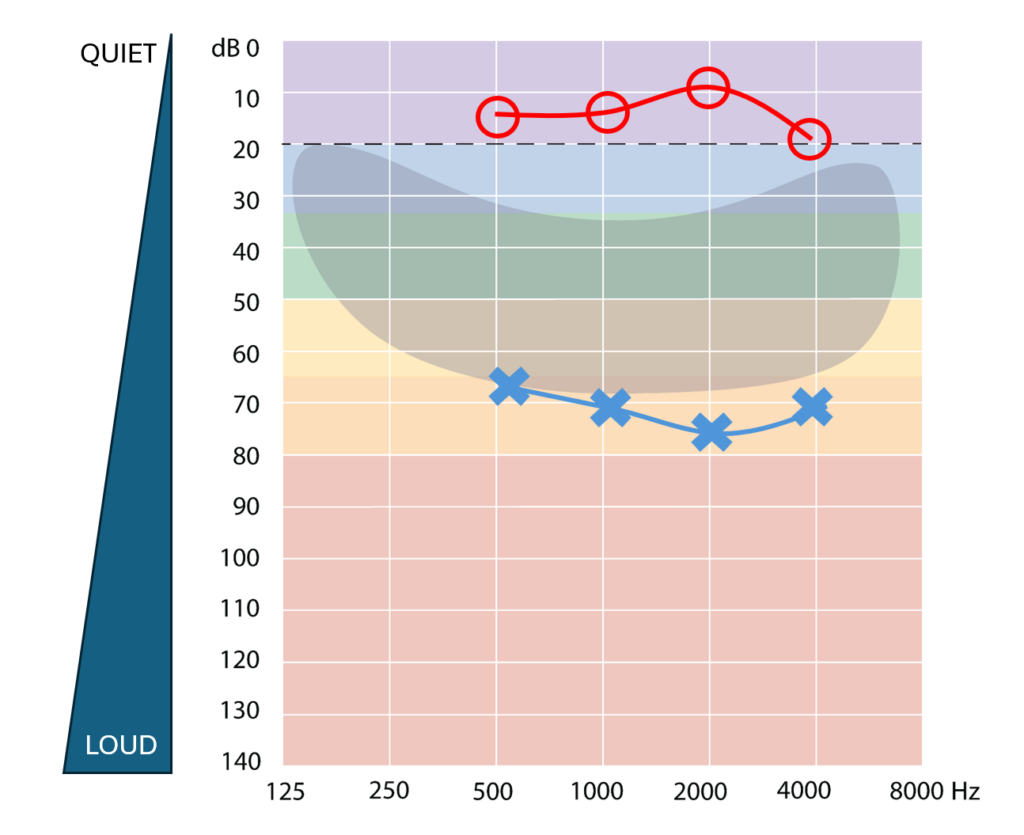
sikio moja lIkiwa katika masafa ya kawaida ya kusikia na sikio lingine limepoteza usikivu kiwango kikubwa.
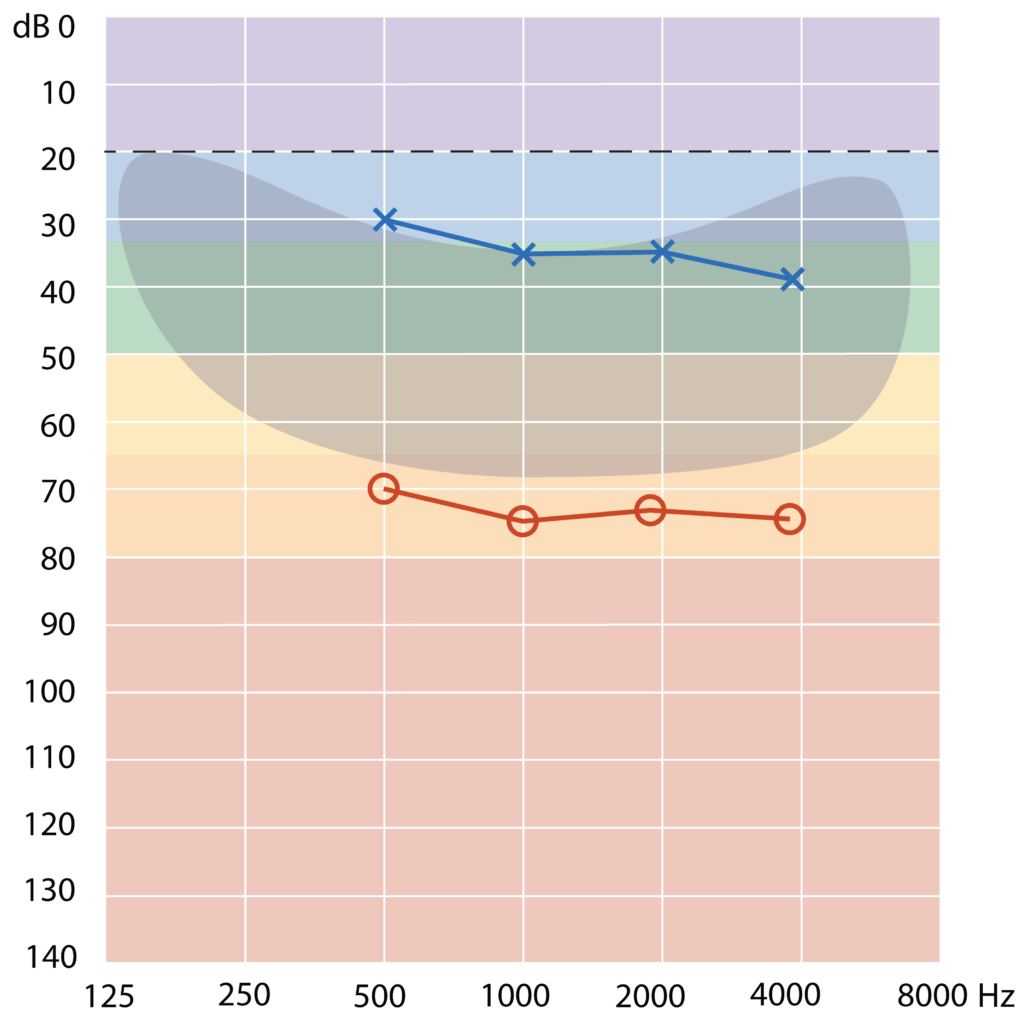
Viwango tofauti vya upotevu wa usikivu kwa zaidi ya dB15 kati ya sikio la kulia na la kushoto.
Swali
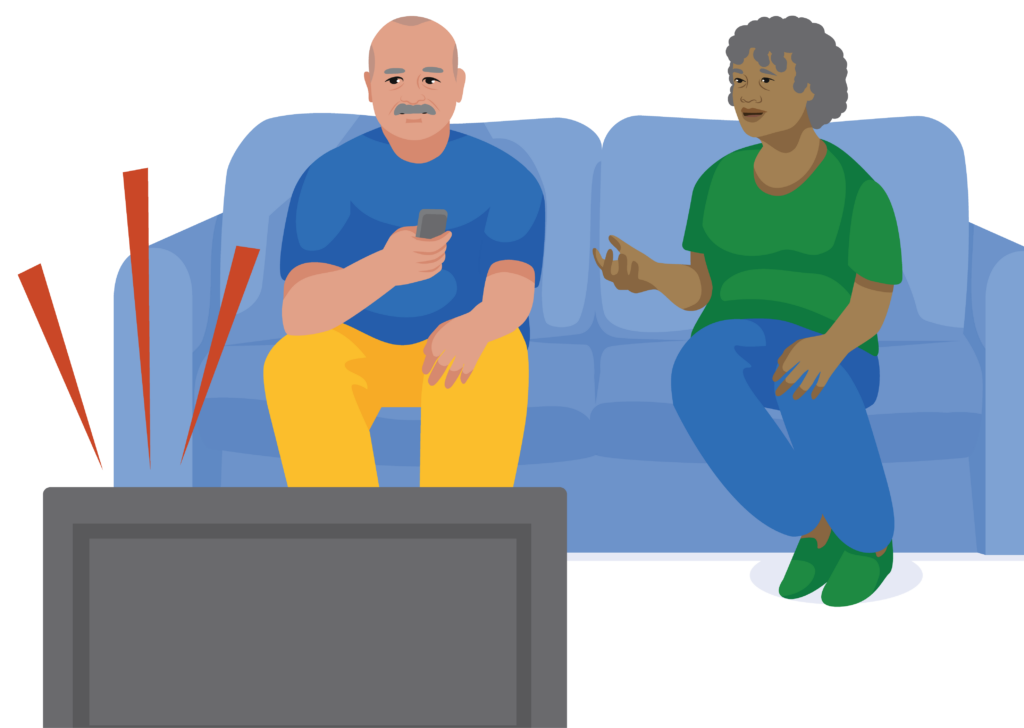
UnamKumbuka John?
John amestaafu na anaishi na mkewe Mary.
John alienda eneo la kutolea huduma ya afya ya eneo lake kwa ajili ya kupima Afya ya masikio na kupima usikivu. Alijibu kwa kujiamini wakati wa kipimo.
Angalia kiwango cha sauti ambacho kinaweza kusikika kwa kila masafa:
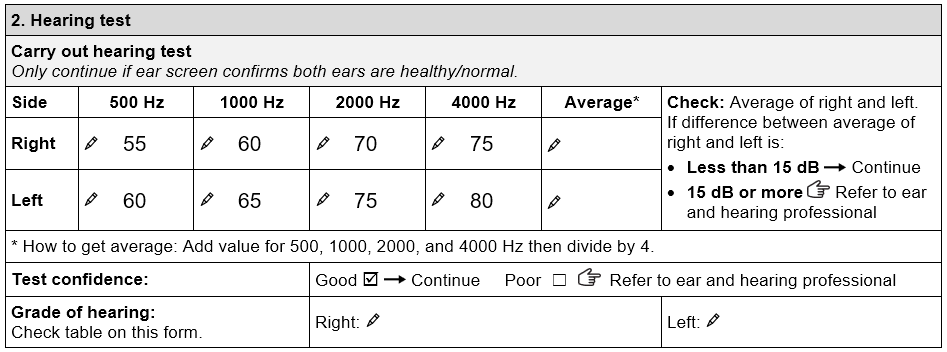
1. Je, ni iwastani gani ni sahihi wa kiwango cha chini kabisa ambacho kinawezakusikika kwa sikio la upande wa kulia wa John?
Chagua jibu moja.
Jibu sahihi ni 65 dB !
Ni wastani unaopatikana kwa kujumlisha nambari zote na kuzigawanya kwa nne.
2. Je, ni wastani upi sahihi wa kiwango cha chini kabisa ambacho sikio la upande wa kushoto wa John linaweza kusikia?
Chagua jibu moja.
Jibu sahihi ni dB 70 dB!
Ni wastani unaopatikana kwa kujumlisha nambari zote na kuzigawanya kwa nne.
3. Je, Yohana ana tofauti chini ya dB 15 kati ya sikio lake la upande wa kulia na la upande wa kushoto?
Chagua jibu moja.
Jibu sahihi ni "Ndiyo"!
Tofauti ni chini ya dB 15. Mhudumu wa afya anaweza kuendelea.
Angalia kiwango cha upotevu wa usikivu kwenye jedwali lililo hapa chini au kwenye Fomu ya tathmini .
| Daraja | Wastani |
| Ndani ya kiwango cha kawaida | Wastani wa chini ya dB 20 |
| Kupoteza kusikia kwa kiwango kidogo | Wastani wa 20-34 dB |
| Kupoteza usikivu kwa kiwango cha wastani | Wastani wa 35-49 dB |
| Kupoteza usikivu kwa kiwango kikubwa hadi cha wastani | Wastani wa 50-64 dB |
| Kupotea kwa usikivu kwa kiwango kikubwa | Wastani wa 65-79 dB |
| Kupotea kwa usikivu kwa kiwango kikubwa zaidi | Wastani wa zaidi ya 80 dB |
4. Je, sikio la kulia la John limepoteza usikivu kwa kiwango gani?
Chagua jibu moja.
Upotevu mkubwa wa kiwango cha kusikia ni sahihi!
65 dB iko katika safu ya upotezaji wa usikivu kwa kiwango kikubwa.
5. Je, sikio la kushoto la John limepoteza usikivu kwa kiwango gani ?
Chagua jibu moja.
Upotevu mkubwa wa kiwango cha kusikia ni sahihi!
70 dB iko katika safu ya upotezaji mkubwa wa kiwango cha kusikia.
5. Rekodi matokeo kwa kila sikio
- Andika wastani wa viwango vya kusikia kwenye sehemu ya kipimo cha usikivu katika fomu
- Rekodi kujiamini kwako katika kufanya kipimo
- Rekodi kiwango cha kusikia kwa sikio la upande wa kulia na la upande wa kushoto.
Fuata hatua iliyopendekezwa kwa kulingana na kiwango cha upotevu wa usikivu kinachopatikana katika jedwali la kiwango cha upotezaji wa usikivu .
UnamKumbuka John?

Mhudumu wa afya anarejea kwenye jedwali linaloonyesha kiwango cha upotevu wa usikivu.
John ni mtu mzima alieyepoteza usikivu katika masikio yote mawili kwa kiwango kikubwa. Mhudumu wa afya anaweza kuendelea kumpatia vifaa saidizi saidizi vya kusikia.
Swali

UnamKumbuka Malicka?
Angalia matokeo ya kipimo cha usikivu cha Malicka.
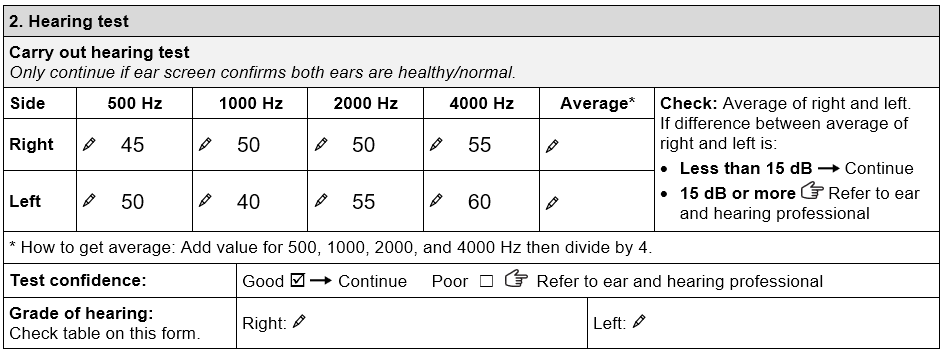
Piga hesabu ya Wastani wa upotezaji wa usikivu kwa sikio la kulia na la kushoto la Malicka.
1. Je, tofauti kati ya sikio la kulia na la kushoto la Malika ni chini dB 15?
Chagua jibu moja.
Jibu sahihi ni "Ndiyo"!
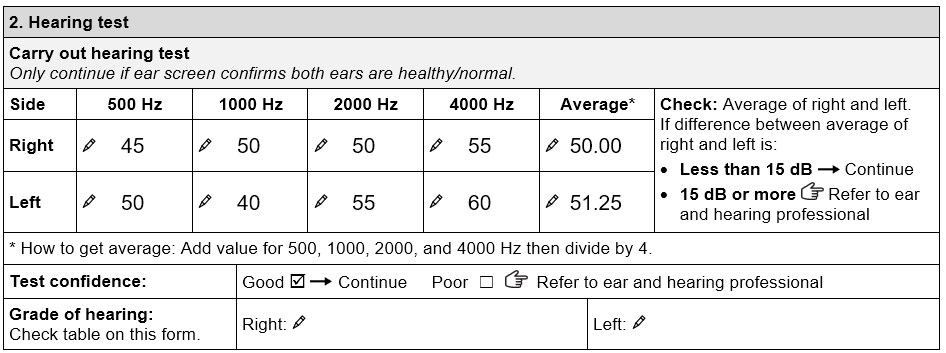
Mhudumu wa afya anaweza kuendelea.
Angalia jedwali la kiwango cha upotevu wa usikivu.
| Daraja | Wastani |
| Ndani ya kiwango cha kawaida | Wastani wa chini ya dB 20 |
| Kupoteza kusikia kwa kiwango kidogo | Wastani wa 20-34 dB |
| Kupoteza usikivu kwa kiwango cha wastani | Wastani wa 35-49 dB |
| Kupoteza usikivu kwa kiwango kikubwa hadi cha wastani | Wastani wa 50-64 dB |
| Kupotea kwa usikivu kwa kiwango kikubwa | Wastani wa 65-79 dB |
| Kupotea kwa usikivu kwa kiwango kikubwa zaidi | Wastani wa zaidi ya 80 dB |
2. Je, sikio la kulia la Malika limepoteza usikivu kwa kiwango gani?
Chagua jibu moja.
Jibu sahihi ni Kupotea kwa usikivu kwa kiwango cha kadri!
Wastani wa kiwango cha chini kabisa ambacho sikio la kulia na Malicka linaweza kusikia ni 50.00 dB. Kwa wastani upotevu wa kadri kiwango cha kusikia ni kati ya 50-64 dB.
3. Je, sikio la kushoto la Malicka limepoteza usikivu kwa kiwango gani ?
Chagua jibu moja.
Jibu sahihi ni Kupotea kwa usikivu kwa kiwango cha kadri!
Wastani wa kiwango cha sauti ambacho sikio la upande wa kushoto la Malika linaweza kusikia ni 51.25 dB. Kupotea kwa usikivu wa kiwango cha kadri ni kati ya 50-64 dB.
Eleza matokeo ya kipimo
Baada ya kukamilisha kipimo cha usikivu na kutambua kiwango cha Kupotea kwa usikivu, mwelezee mhusika matokeo kama mtu huyo anaweza kufaidika na vifaa saidizi vya kusikia.
UnamKumbuka Malicka?

Baada ya kipimo cha usikivu alichofanya Malicka, Mhudumu wa afya anaeleza kuwa Malicka amepoteza usikivu kwa kiwango kikubwa. Hii inamaanisha kuwa Malicka anaweza kupata shida kuelewa maneno hata kama yuko kwenye mazingira tulivu.
Kutumia vifaa saidizi vya kusikia kUnaweza kurahisisha kuwasiliana na familia yake, hasa katika shughuli za kijamii.
Malika anathibitisha kuwa angependa kufanyiwa tathmini ili kuona kama vifaa saidizi vya kusikia vitasaidia.